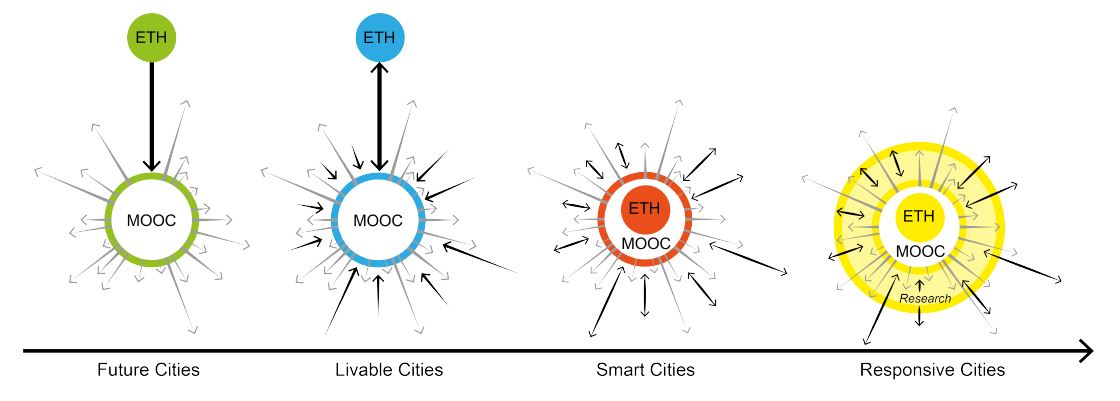ETH wants their funded projects to offer a benefit for their residential students. For a MOOC, this can be a special challenge, because the first thing you think of is the large global audience. But a MOOC can also be useful for one’s own students, for example when MOOC content is used to prepare or deepen face-to-face lectures, or when it is a relevant part of an ETH internal course where interaction between face-to-face students and international participants enriches the learning experience.
Different course formats can be used, dependent on target group and course setting:
| Format | Setting | Target group | Platform |
| Standalone online course | Internal ETH course with additional online self-study material or an online entry test. | ETH students | Moodle / SMS |
| Blended course | combination of face-to-face teaching and distance learning | ETH students | Moodle / SMS |
| Standalone (Swiss)MOOC | dissemination and as learning resource for internal course | global audience, ETH students | edX.org /SMS |
| Hybrid MOOC | MOOC and internal course take place simultaneously and participants of both groups interact with one another | global audience, ETH students | edX.org / SMS |
The impression arises, that SMS seems to be suitable as a platform for all formats. However, Moodle is by far the most obvious choice for internal courses with perhaps a few non-ETH participants. Not only because the number of interaction possibilities (assignments, question types, etc.) is the greatest, but also because both the creation of the environment and the enrolment of students enrolled in the course via MyStudies are automatically processed. If, however, a course is also intended for external students and video is an important part of the transfer of knowledge, then SMS is a good choice. If the goal is to reach a very large audience, then a MOOC is a good choice. If you want to offer the course as a MOOC at a later date, it also makes sense to work with SMS because content can easily be copied from Open EdX to EdX. EdX provides powerful assistance in marketing the content, something for which the course team is responsible in the case of SMS.
NB: Please also note the data protection policy for the three different platforms.
Hybrid MOOCs and flipped classroom
If you run a MOOC simultaneously and interlocking with your internal class, we call that a hybrid MOOC. In a hybrid MOOC, you have to deal with two different groups, ETH students and a global audience. A challenge can be the difference in pre-knowledge between both target groups (the ETH students on the one hand and a worldwide community on the other). In addition, the global audience only follows part of the learning activities, namely only those offered in the MOOC. So the MOOC itself should be a standalone online course.
If you want to interlock the MOOC with your residential course, it can be helpful to know more about the flipped classroom concept.
“Flipped learning is a pedagogical approach in which direct instruction moves from the group learning space to the individual learning space, and the resulting group space is transformed into a dynamic, interactive learning environment where the educator guides students as they apply concepts and engage creatively in the subject matter.” – Source: The Flipped Learning Network
Example of hybrid MOOCs
The example of Future Cities below shows how the course team experimented with interaction between target groups and how they tried to integrate lessons learned every time they started a new MOOC project.
Examples of hybrid MOOCs in the Future Cities X-series
Increasing interaction between ETH students and the global audience

Future Cities
The ETH course on “Future Cities” and Singapore-ETH Centre (SEC) Future Cities Laboratory
research results were translated to a MOOC called “Future Cities”. This MOOC disseminates information to participants. Participants send extensive feedback and images as results of exercises.
Livable Cities
The ETH course on “Livable Cities” was taught as pilot with ETH students in FS 2015, feedback from MOOC “Future Cities” has been integrated. The ETH course and the new SEC Future Cities Laboratory research results were translated to a new MOOC “Livable Cities”. “Livable Cities” disseminates information to participants, and the participants contribute their experiences to the MOOC.
Smart Cities
The ETH course on “Responsive Cities” was taught as pilot with ETH students in HS 2015. After feedback from this course and from the MOOC “Livable Cities”, it has been adapted for simultaneous learning with the third Future Cities MOOC “Smart Cities”. Participants from both course settings interact, build upon each other’s experiences and create new knowledge.
Responsive Cities
The ‘Responsive Cities’ MOOC continues the exploration of a new learning experience for ETH students. The inclusive MOOC allows students to interact with participants around the world and to engage in multicultural discussions. ETH students, participating in the exclusive ETH ‘Responsive Cities’ elective and in the MOOC at the same time, add broader knowledge on the topics explored than they could acquire if they would work exclusively with their ETH colleagues. ETH students interact with and learn from citizens around the world about experiences in other cities through the successful techniques developed in the first urban MOOCs.